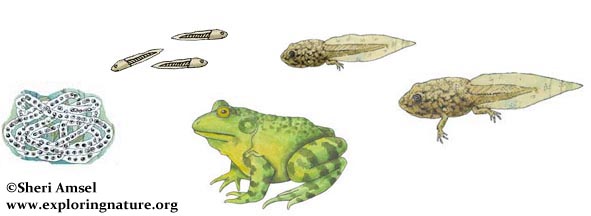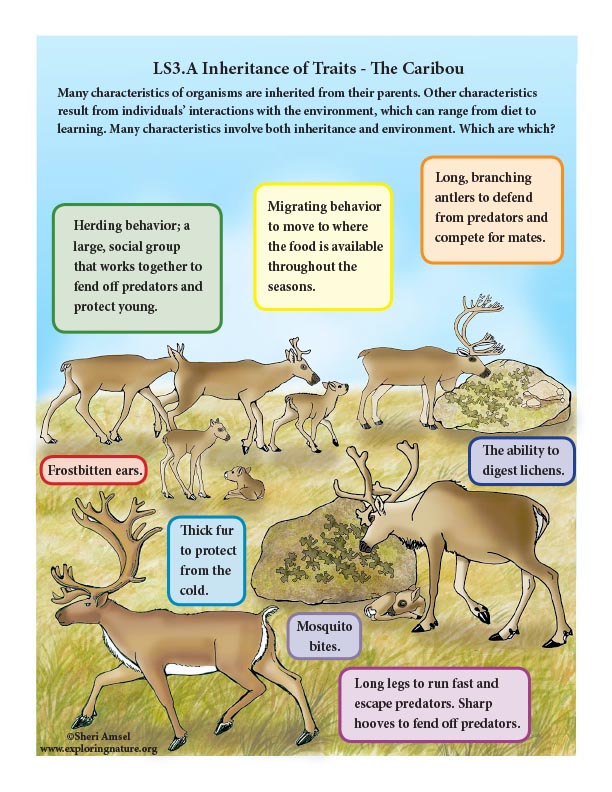

_________________________________________________________________________________________________________________________________________________________
Disciplinary Core Ideas
LS3.A: Inheritance of Traits
• Young animals are very much, but not exactly like, their parents. Plants also are very much, but not exactly, like their parents. (1-LS3-1)
LS3.B: Variation of Traits
• Individuals of the same kind of plant or animal are recognizable as similar but can also vary in many ways. (1-LS3-1)
Performance Expectations Students who demonstrate understanding can:
1-LS3-1. Make observations to construct an evidence-based account that young plants and animals are like, but not exactly like, their parents.
[Clarification Statement: Examples of patterns could include features plants or animals share. Examples of observations could include leaves from the same kind of plant are the same shape but can differ in size; and, a particular breed of dog looks like its parents but is not exactly the same.] [Assessment Boundary: Assessment does not include inheritance or animals that undergo metamorphosis or hybrids.]
_________________________________________________________________________________________________________________________________________________________
Use the Template and Resource Links to Fulfill NGSS
l. Goals:
Essential Questions:
NGSS Note: Think, question, entertain ideas.
ll. Introductory Activities to Assess Prior Knowledge
A. Simple Activities - that assess students’ understanding of inherited characteristics.
Match the Baby Animals to Their Grown Up (Black and White)
What Will I Be When I Grow Up? Matching
Life Cycles: Print-Copy-Cut-Paste
Butterfly (Monarch) Life Cycle - Activity
B. Brainstorming Session
Question: Look at a phptograph of a litter of kittens, puppies, foxes, etc. In which ways are the babies like the parent animal or like each other and in which ways are they different?
1. Break students down into groups of 3-4.
2. Ask students to generate a list.
3. Discuss
lll. New Knowledge - Text
Read inherited traits and characteristics:
Adaptation Illustrated
Helping Baby Survive
Life Cycles - Plants and Animals
Heredity - Read Aloud (Grade 1)
Activities to Reinforce Learning
Finding Inherited Traits in Dogs (Grade1)
Finding Inherited Traits in Foxes (Grade1)
Finding Inherited Traits in Pea Plants (Grade 1)
Inheritance of Traits (in Bears) - Critical Thinking Activity
Inheritance of Traits (in Caribou) - Matching
Inheritance of Traits (in Dogs) - Critical Thinking Activity
Heredity and Pollination - Authentic Performance Activity
Identifying Monster Traits (Grade1)
Inheritance and Variation of Traits - Vocabulary Cut and Paste
Variation of Traits in Animals - Authentic Performance
Variation of Traits in Dogs - Matching
Variation of Traits in Pea Plants - Matching
Variation of Traits - Plant Investigation
Examples of Models (depicts the concept expressed in the reading):
• Ask students to create a model showing how baby animals grow up to resemble their parents.
Variation of Traits in Dogs - Poster
Inheritance of Traits in the Caribou - Mini-Poster
V. Summarize Knowledge - Enduring Understandings
Vl. Next Generation of Science Standards (NGSS) - Grade 1
Disciplinary Core Ideas
LS3.A: Inheritance of Traits
• Young animals are very much, but not exactly like, their parents. Plants also are very much, but not exactly, like their parents. (1-LS3-1)
LS3.B: Variation of Traits
• Individuals of the same kind of plant or animal are recognizable as similar but can also vary in many ways. (1-LS3-1)
Science and Engineering Practices (NGSS)Constructing Explanations and Designing Solutions
Constructing explanations and designing solutions in K–2 builds on prior experiences and progresses to the use of evidence and ideas in constructing evidence-based accounts of natural phenomena and designing solutions.
• Make observations (firsthand or from media) to construct an evidence-based account for natural phenomena. (1-LS3-1)
Crosscutting Concepts (NGSS)
Patterns
• Patterns in the natural and human designed world can be observed, used to describe phenomena, and used as evidence. (1-LS3-1)
Performance Expectations Students who demonstrate understanding can:
1-LS3-1. Make observations to construct an evidence-based account that young plants and animals are like, but not exactly like, their parents.
[Clarification Statement: Examples of patterns could include features plants or animals share. Examples of observations could include leaves from the same kind of plant are the same shape but can differ in size; and, a particular breed of dog looks like its parents but is not exactly the same.] [Assessment Boundary: Assessment does not include inheritance or animals that undergo metamorphosis or hybrids.]
Common Core State Standards Connections:
ELA/Literacy
1.RI.1 Ask and answer questions about key details in a text. (1-LS3-1)
W.1.7 Participate in shared research and writing projects (e.g., explore a number of “how-to” books on a given topic and use them to write a sequence of instructions). (1-LS3-1)
W.1.8 With guidance and support from adults, recall information from experiences or gather information from provided sources to answer a question. (1-LS3-1)
Mathematics
MP.2 Reason abstractly and quantitatively. (1-LS3-1)
MP.5 Use appropriate tools strategically. (1-LS3-1)
1.MD.A.1 Order three objects by length; compare the lengths of two objects indirectly by using a third object. (1-LS3-1)
When you research information you must cite the reference. Citing for websites is different from citing from books, magazines and periodicals. The style of citing shown here is from the MLA Style Citations (Modern Language Association).
When citing a WEBSITE the general format is as follows.
Author Last Name, First Name(s). "Title: Subtitle of Part of Web Page, if appropriate." Title: Subtitle: Section of Page if appropriate. Sponsoring/Publishing Agency, If Given. Additional significant descriptive information. Date of Electronic Publication or other Date, such as Last Updated. Day Month Year of access < URL >.
Amsel, Sheri. "Grade 1 - 1-LS3 Heredity: Inheritance and Variation of Traits" Exploring Nature Educational Resource ©2005-2024. December 13, 2024
< http://www.exploringnature.org/db/view/Grade-1-1-LS3-Heredity-Inheritance-and-Variation-of-Traits >


